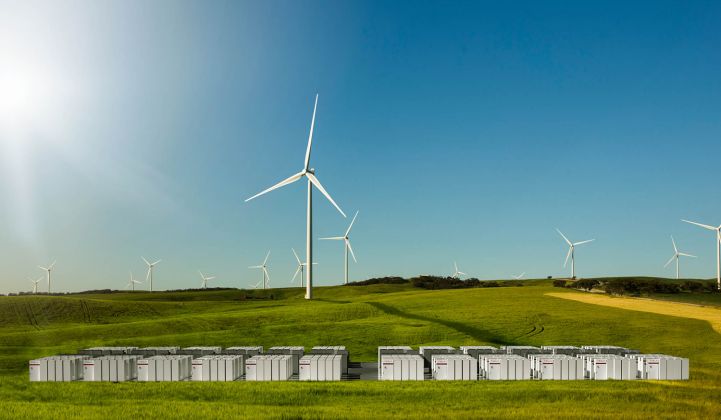Credit where credit is due: Elon Musk made a crazy, eye-catching promise, and he delivered.
After a series of regional blackouts that shook South Australia in September 2016 and February 2017, a fierce debate emerged over how to manage the grid. Musk inserted himself into the debate, saying on Twitter that he could deliver 100 megawatts of storage in 100 days or it would be free.
Musk later noted that the cost of losing that bet would have been around $50 million, Business Insider reports. That would have been a tough blow to a company that just posted its largest quarterly loss. But it won't happen, because regulatory testing has begun ahead of the December 1 deadline.
"The world's largest gridscale battery - the Hornsdale Power Reserve battery - charged for the first time at 8.36am and reached 31 MW in 2 mins," tweeted Audrey Zibelman, the leader of Australia's energy market operator, on Friday.
That's a welcome success for Tesla, which recently announced a three-month delay in the Model 3 production schedule and a $671.16 million quarterly loss.
In addition, the company's willingness to take on ambitious projects -- as in Australia and Puerto Rico -- has contributed to difficulties in delivering shipments to rank-and-file installers who count on the Powerwall and Powerpack.
Will the South Australia project amount to a one-off attention-grabber for Tesla, or a more enduring business strategy?
"You cannot have a business model that's just waiting for these events to occur so you can jump in and be a savior," said Ravi Manghani, energy storage director at GTM Research. But, he added, "They've had two such projects done in the last year, so there is some amount of regularity to these emergency events."
The other project is the Aliso Canyon storage procurement, which built local capacity assets in response to a massive natural gas leak in Southern California. Tesla produced a 20-megawatt/ 80-megawatt-hour system for Southern California Edison in a four-month window. That wave of storage projects, which included several other companies, came on-line in January.
At the utility scale, contracts are scarce enough that companies see significant swings from quarter to quarter, Manghani noted. Until the residential and commercial segments swell to provide more steady work, battery vendors and storage developers have little choice but to chase down whatever opportunities arise.
"You have to be scrappy, and you have to be opportunistic," he said.
Developers also benefit from scale. Tesla deployed 100 megawatts in this single project. That's far more efficient than selling 100 separate 1-megawatt commercial systems, and commercial installers aren't moving that many units in a quarter yet.
It's the biggest lithium-ion system so far, but has a limited duration: only 129 megawatt-hours to its 100 megawatts of power capacity. Tesla has noted the system holds enough energy to power more than 30,000 homes, roughly the number that lost power during the blackout. But it could only power them for about an hour.
That could be long enough to keep customers powered until traditional backup generation sources come on-line, preventing a repeat of the rolling blackouts that spurred the project.
Australians will have to wait for storage paired with renewables to compete with gas peakers at scale. That should happen by 2025, according to research by GTM and Wood Mackenzie.
Most of the time, the grid won't be threatening to fall apart, and the battery system will be able to provide ancillary services and integrate intermittent generation from an adjacent wind farm. Australian energy experts have wondered whether such a large storage system can operate profitably in such a capacity.
Part of the challenge is that Australia lacks a capacity market, so there isn't an isolated mechanism for compensating peak capacity, Manghani said. In this way it resembles Texas more than California or PJM.
Even without a distinct capacity contract, there's a cost associated with reliability events. Energy prices shoot up when there isn't enough to go around, and the economic fallout from statewide blackouts costs the region dearly.
"The exact cost-competitiveness of battery solutions versus other peaking assets is something you can have an argument about, but there is no question that that particular geography has a need for some form of peaking capacity that can play a role in these reliability events," Manghani said. "They may not occur more than three, four, five times a year, but when they occur, you have to have these assets."
Given that need, storage offers a much faster deployment than a traditional gas peaker, but it's also more modular and scalable.
Gas plants demand a certain scale for the economics to make sense, so they end up imposing a higher capital expense upfront (South Australia also procured a 250-megawatt gas plant for around $360 million). With storage, the state can build what it needs now, and if peak demands grow over the next few years, it can add more. It doesn't tie up capital like the traditional plants do.
In the long run, this project takes the Aliso Canyon procurements to a global scale. It's more proof that storage developers can act fast.
"Storage assets can be brought on-line rather quickly and, from a grid planning standpoint, these can be more modular and flexible than traditional assets," Manghani said.
Join GTM Dec. 12-13 for a deep dive into the budding domestic energy storage market at the U.S. Energy Storage Summit 2017. Utilities, financiers, regulators, technology innovators and storage practitioners will all come together for two full days of data-intensive presentations, analyst-led panel sessions with industry leaders, and extensive, high-level networking.




